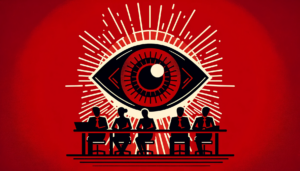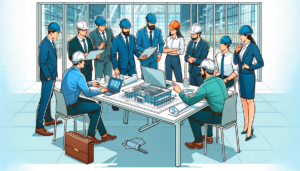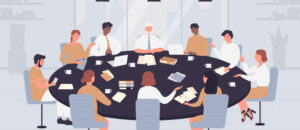How effective organizational design can improve employee experience
- 6 Min Read
Elevating employee experience with core organizational design principles and a design thinking methodology
- Author: HRD Connect
- Date published: Mar 22, 2022
- Categories

Organizational design is a critical aspect of creating an effective and engaging employee experience. The way an organization is structured, the technologies it uses, and the culture it fosters can all have a profound impact on the productivity, satisfaction, and well-being of its employees. To achieve outstanding employee experience, HR leaders should embrace organizational design thinking. This approach can improve employee experience and strategies for managing the employee lifecycle, promoting employee performance, and building an employer brand. What’s more, it creates a workplace culture that fosters transparency, trust, autonomy, empowerment, and a sense of belonging for their employees.
Organizational design thinking
Design thinking has become increasingly popular in business and HR circles over the past few years. It focuses on the user experience and uses empathy, creativity, and experimentation to develop innovative solutions. In the context of employee experience, design thinking offers a powerful framework for HR leaders to create a work environment that is engaging, motivating, and fulfilling for their employees.
How design thinking works in practice
To implement design thinking, HR leaders must create a culture that values empathy, collaboration, and experimentation. This requires involving employees in the design process and creating opportunities for them to provide feedback, share ideas, and participate in testing and iterating solutions.
- Conduct empathy interviews. HR leaders can conduct empathy interviews with employees to understand their needs, pain points, and preferences. This may range from listening actively to employees’ stories to using open-ended questions to gain insights into their experiences. By gathering this information, HR leaders can identify areas for improvement and develop solutions that address the needs and concerns of employees.
- Use co-creation sessions. HR leaders can use co-creation sessions to engage employees in the design process. These sessions involve bringing together a diverse group of employees to brainstorm ideas, share perspectives, and develop solutions collaboratively.
- Create prototypes and conduct user testing. HR leaders can use design thinking to create prototypes of new policies, processes, and technologies. Employees test the prototypes and organizations use the feedback to refine their solutions. HR leaders can thereby ensure that the organizational design prototypes are effective and user-friendly.
- Measure and track employee feedback. HR leaders can use feedback from employees to measure and track the success of their design thinking initiatives. This involves collecting feedback through surveys, focus groups, and other channels. By measuring and tracking employee feedback, HR leaders can ensure that their design thinking initiatives are having a positive impact on the employee experience.
Why design thinking matters
Design thinking enables HR leaders to take a more empathetic and collaborative approach to understanding and solving organizational challenges. By using design thinking principles, HR leaders can encourage employees to share ideas, take risks, and experiment with new solutions. This can lead to a more dynamic and innovative work environment. Moreover, it creates a culture that fosters transparency, trust, autonomy, empowerment, and a sense of belonging. This can lead to a more satisfied workforce.
What organizational design principles impact employee experience?
Design thinking helps business leaders to create collaborative and iterative changes to organizational design. But what are the design principles that impact employee experience that HR leaders should pay particular attention to?
Developing a flexible and adaptive organizational structure
An adaptive organizational culture creates an environment that can quickly respond to changing business needs. This may include agile methodologies and adopting a more flexible approach to team structure. Furthermore, it could include creating cross-functional teams between business divisions.
Fostering employee autonomy and empowerment
HR leaders can create a culture of empowerment by giving employees more autonomy to make decisions and take ownership of their work. In practice, this may include allowing employees to set their own goals. Moreover, HR leaders should give employees the resources and freedom to experiment with new ideas.
Building an inclusive and diverse workforce
Organizational design can help HR leaders to develop a hiring process that is free of bias. This ranges from developing policies that support diversity and inclusion to providing training and development opportunities that address issues of bias and discrimination.
Leveraging technology to enhance the employee experience
Integrating technology into the employee experience is a vital aspect of organizational design. From AI to LMS software, HR leaders should consider what tools or technology may help their team address bottlenecks in their workflows or facilitate greater innovation and collaboration within and between teams.
Providing a variety of work settings and experiences
HR leaders should consider the design of their work settings and experiences, particularly as issues with hybrid working such as proximity bias continue to trouble organizations. Organizations can achieve this by providing employees with options for remote work, flexible schedules, and other work arrangements that support work-life balance. Working closely with employees to understand their workplace needs can help HR leaders to design an inclusive working environment.
Why HR leaders must become skilled at organizational design
Developing organizational design principles can help HR leaders to address many of the challenges presented by the rapidly changing business environment. Organizations need to design workplaces that can accommodate hybrid work models. They must design workplaces that create an inclusive culture where all employees feel valued and respected. They should design their organizations to be ready for investments in new tools and platforms. Lastly, they should create a culture that supports experimentation and innovation.
In today’s highly competitive job market, employees have more options than ever before. To attract and retain top talent, organizations need to create an employee experience that is compelling and unique. This means designing workplaces that prioritize employee well-being, professional growth, and meaningful work. By intentionally designing the workplace to enhance employee experience, organizations can create a virtuous cycle of employee satisfaction, engagement, and productivity that drives success for both the employee and the organization.
________________
HRD Connect delivers high-quality analysis, intelligence, and resources for senior HR leaders. We provide invaluable insights and exclusive interviews examining the most innovative practices that help HR leaders meet the challenges they face, including strategy & leadership, talent, rewards & benefits, digital transformation, DE&I, and employee engagement.
Access the latest case studies, thought leadership, and HRD Live Podcast episodes.









